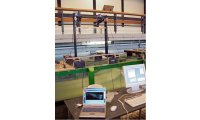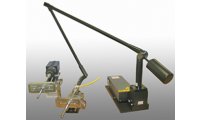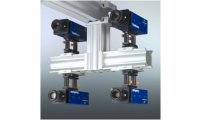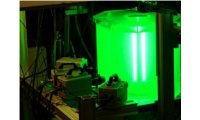
诚信认证:
工商注册信息已核实! 扫一扫即可访问手机版展台
扫一扫即可访问手机版展台
气相聚合反应器中的水动力学研究
| 资料类型: | NONE |
| 资料文件名 | 下载 |
|---|---|
气相聚合反应器中的水动力学研究 |
下载此篇资料 |
Polyolefins are polymers produced from olefins such as ethylene and/or
propylene. Although polyolefins can be produced via different production
methods, the gas-phase polymerization process based on fluidized
bed reactor technology is the most important method for the production
of polyethylene since the 1980’s and also polypropylene is increasingly
produced via the gas-phase polymerization process. Although fluidized
bed reactors have been employed for several decades in the chemical
industry, quantitative information on solids motion and macroscopic
circulation patterns is still incomplete.
To investigate the macroscopic circulation patterns in a freely bubbling,
gas-solid fluidized bed, first the hydrodynamics in two pseudo-2D
columns of different width filled with glass beads and Linear Low Density
Polyethylene (LLDPE) particles have been investigated (both exhibiting
Geldart B type behavior) experimentally with two optical non-invasive
measuring techniques. Particle Image Velocimetry (PIV) combined with
Digital Image Analysis (DIA) has been developed to determine simultaneously
the emulsion phase circulation patterns, bubble hold-up, bubble
size and velocity distributions and visual bubble flow rate profiles.
The combination of DIA with PIV allows correcting for the influence of
particle raining through the roof of the bubbles on the time-averaged
emulsion phase velocity profiles. The number-averaged emulsion phase
vii
SUMMARY
circulation patterns have been measured as a function of fluidization velocity,
bed aspect ratio, bed width and bed material. Moreover, with DIA
the average bubble diameter and averaged bubble velocity as a function
of height and fluidization velocity have been determined and found to
correspond reasonably well with literature correlations. However, the
difference in averaged bubble diameter as a function of the height in the
fluidized bed for the two different particle types could not be explained
by the currently available correlations for the bubble diameter. The difference
in observed bubble properties is attributed to differences in the
particle collisional properties (coefficients of restitution and the particle
friction coefficient).
To verify this hypothesis, the influence of microscopic particle properties
on the hydrodynamics in a bubbling fluidized bed have been investigated
in detail using the Discrete Particle Model (DPM) and the
Two-Fluid Model (TFM). It was concluded that, for the conditions investigated,
indeed bubbles are formed due to collisional dissipation of
mechanical energy. Furthermore, the nature (i.e. due to restitution
or friction) of the energy dissipation is important for the shape of the
bubbles. In addition it is shown that in a bubbling fluidized bed, the
energy is mainly dissipated by friction between particles and particles
and the wall. The influence of the normal restitution coefficient on
the macroscopic circulation pattern was also investigated with the Two-
Fluid Model. The observed influence of the coefficient of restitution in
the normal direction agreed with the influence of the coefficient of restitution
in the normal direction in the DPM. Also the experimental results
obtained with the PIV combined with DIA measurements for the solids
phase and DIA measurements for the bubble behavior were compared
with simulations performed with the DPM and the TFM. It was shown
that the trends for the emulsion phase and the bubble phase can be
predicted with the DPM.
The solids and bubble behavior in a freely bubbling, three dimensional,
gas-solid fluidized bed has been experimentally investigated using
different bed materials, different bed aspect ratios at different superficial
gas velocities by performing Positron Emission Particle Tracking
viii
(PEPT) experiments. The fluidized bed was filled with either glass beads
or with linear low density polyethylene (LLDPE). At lower superficial gas
velocities two distinct vortices appear above each other for both types of
bed material; when the superficial gas velocity is increased, the lower
vortex disappears and the top vortex spans the entire length of the bed.
Although qualitatively the same phenomena were observed, the timeaveraged
solids phase circulation rate in the fluidized bed filled with
LLDPE particles was higher than the time-averaged solids phase velocity
in the fluidized bed filled with glass beads. When the bed aspect ratio is
increased from 1 to 1.5, the vortices become elongated without altering
the solids circulation rate. Differences in the particle-particle collisional
properties (coefficients of restitution and friction particle coefficients) are
believed to be the cause of the observed quantitative differences in the
bed hydrodynamics via their influence on the bubble properties.
Finally, the hydrodynamic behavior of industrial scale bubbling fluidized
bed reactors, a 3D Discrete Bubble Model (DBM) has been used.
In the DBM, an Euler-Lagrange model, the bubbles are treated as discrete
elements and the bubble trajectories are tracked individually, while
the emulsion phase is considered as a continuum and is described with
the continuity and Navier-Stokes equations. The main advantage of the
DBM is that it fully accounts for the two-way coupling, allowing computation
of the prevailing macroscopic circulation patterns in large scale
gas-fluidized beds. We have examined the effects of bubble-bubble interactions
on the macro-scale velocity profiles using the DBM. It has been
found that the extent of the macroscopic circulation is significantly increased
by the bubble-bubble interaction forces.







